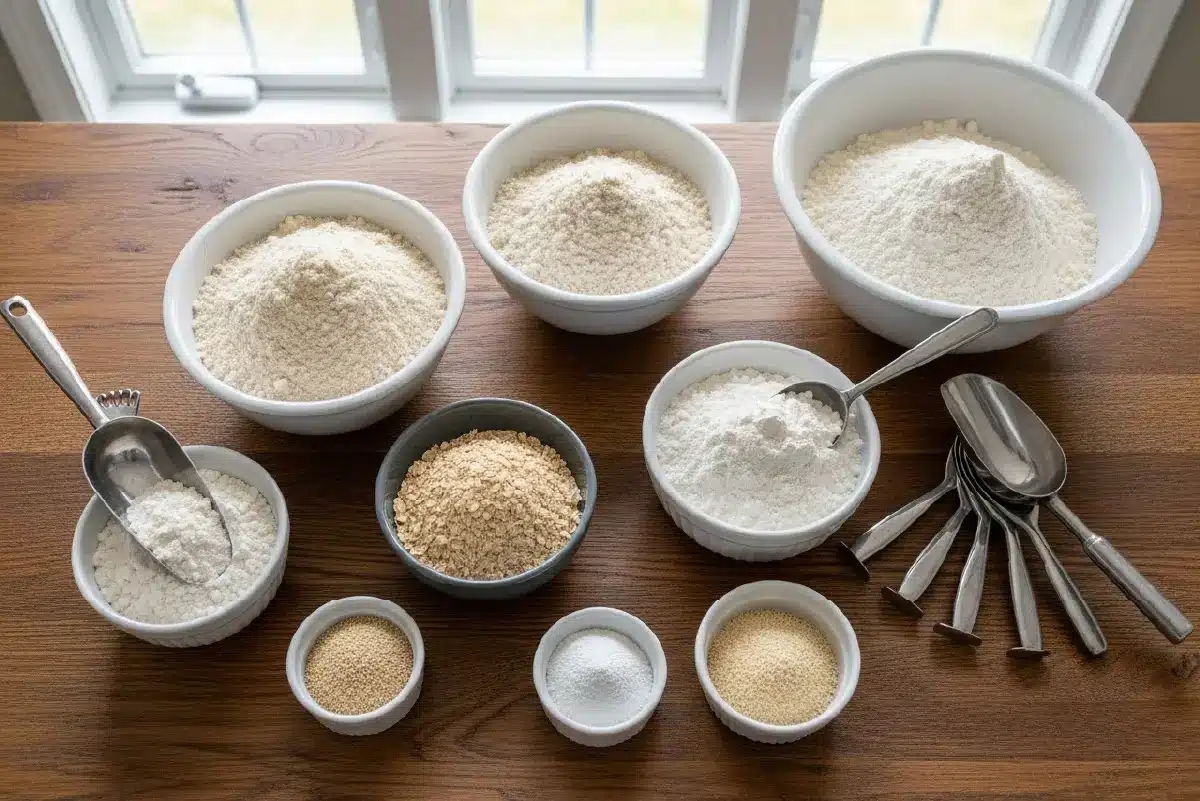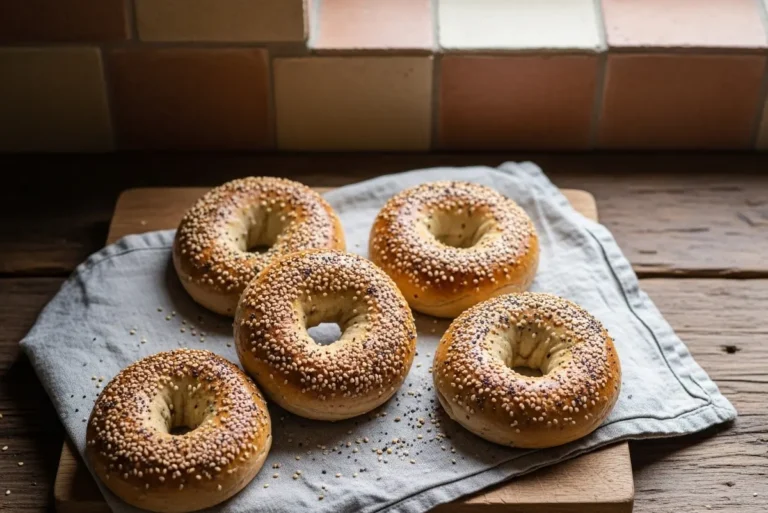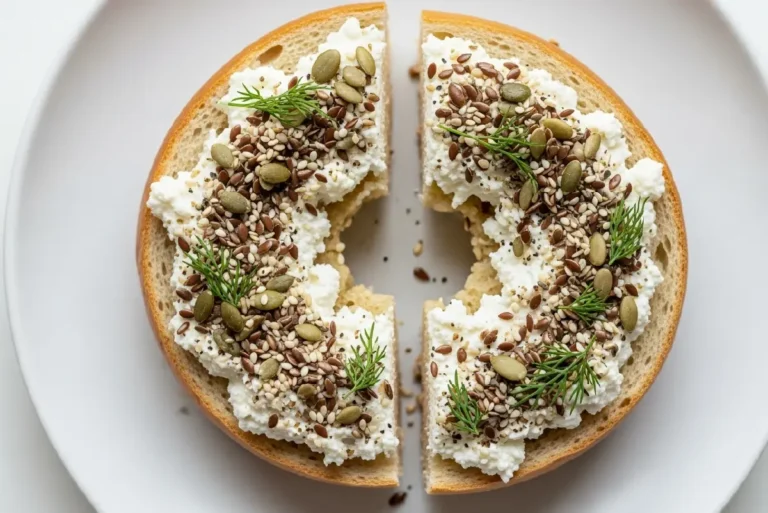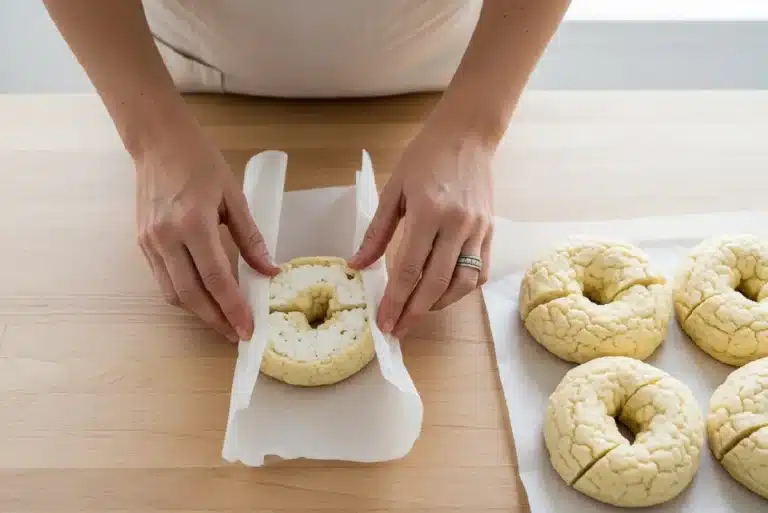Gluten free flour swap for bagels—it sounds simple, right? But if you’ve ever tried to recreate that chewy, golden-crusted bite using gluten-free flour, you know it’s not as easy as tossing in a 1:1 substitute and hoping for the best.
I’ve been there—standing in my kitchen after a long day, flour dusted on my sleeves, wondering why my “healthy” bagels came out dense and crumbly instead of soft and satisfying.
But here’s the good news: with the right flour blend (and a little know-how from my grandma’s tried-and-true kitchen wisdom), you can make gluten-free bagels that taste like the real thing—comforting, chewy, and full of heart.
Let’s dig in. I’ll walk you through the best swaps, my go-to tricks, and how to make this feel doable—even on a school night.
Note Before You Try
This gluten-free bagel guide is based on personal experience and common ingredient research. It is not a substitute for medical advice or professional dietary guidance. If you have gluten sensitivities, allergies, or health concerns, consult a qualified healthcare provider before trying new recipes. Results may vary depending on the flour brand and method used.
What You Need to Know About a Gluten Free Flour Swap for Bagels
When it comes to a successful gluten free flour swap for bagels, it’s not just about finding a wheat alternative—it’s about replicating the very structure that makes a bagel… well, a bagel. That signature chewy texture and golden crust come from the high gluten content of traditional bread flour. Gluten is what gives bagel dough its stretch, strength, and that unmistakable bakery-style bite.
In gluten-free baking, we lose that natural elasticity. Most gluten free flours—like rice, oat, or almond—don’t have the built-in protein needed to trap air or hold shape through boiling. So, if you’re aiming for a proper gluten free flour swap for bagels, you’ll need to recreate that structure from scratch.
It’s like rebuilding a house without nails. Totally doable—but you’ll need to choose the right tools. The flour blend, hydration level, and use of binding agents all work together to create that firm yet tender crumb we crave in every bite.
What Makes Bagels So Unique?
- High-Protein Dough: Traditional bagels use bread flour for gluten strength.
- Boiling Before Baking: This locks in moisture and forms the dense, shiny crust.
- Slow Proofing (Optional): Cold fermentation improves chew and flavor.
To pull this off without gluten, we’ll need smart swaps—flours that mimic the protein structure, binders that add elasticity, and a method that honors what makes bagels truly bagels. Up next: how to choose those gluten free flours wisely.
What is a substitute for bread flour in bagels?
To replace bread flour in gluten-free bagels, use a blend of sorghum or oat flour with tapioca or potato starch, and add binders like xanthan gum or psyllium husk. This combination supports the structure, chewiness, and rise needed for a satisfying bagel.
Choosing the Right Gluten Free Flour Swap for Bagels
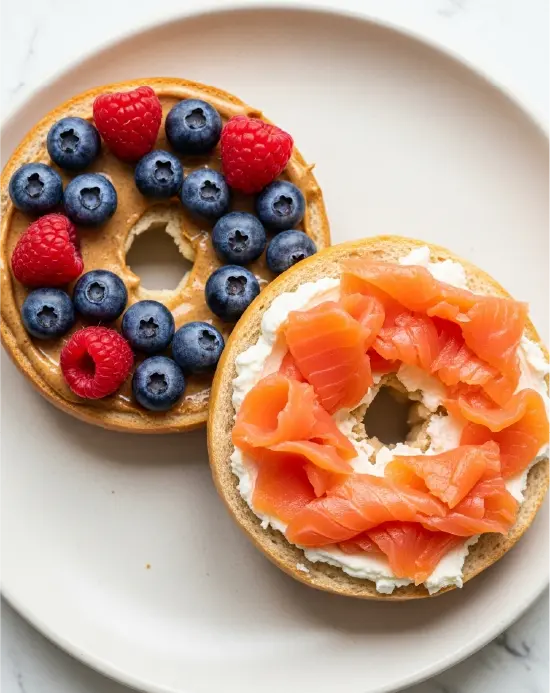
Let’s be honest—standing in the baking aisle, staring at bags of almond, sorghum, buckwheat, and rice flour, it’s easy to feel overwhelmed. But when it comes to a reliable gluten free flour swap for bagels, it’s not about picking the fanciest option. It’s about understanding what your bagel dough needs—and which flours can deliver.
Bagels aren’t cupcakes. They need strength, stretch, and moisture control. That’s why a single gluten-free flour rarely works well on its own. Most of the time, a blend is your best bet. Here’s what to consider:
What to Look for in a Flour Blend
- Protein Content: Flours like sorghum and oat have higher protein and better chew potential.
- Starches for Stretch: Tapioca and potato starch add elasticity and softness.
- Binders: Xanthan gum or psyllium husk mimic gluten’s structure and help hold everything together.
- Flavor Neutrality: Stick with mild-tasting flours (oat, rice) if you’re after a traditional-style bagel.
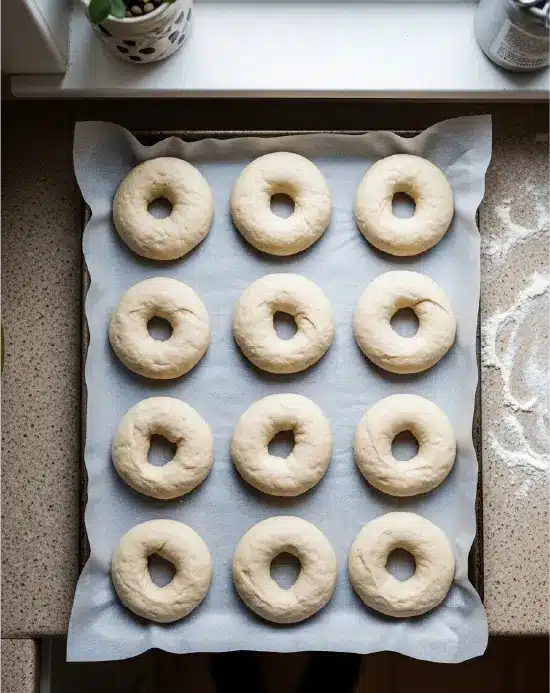
If you’re mixing your own blend at home, start with:
- 1 cup sorghum flour
- ¾ cup tapioca starch
- ½ cup potato starch
- 1 tsp xanthan gum
This combination gives you a springy, boil-ready dough that rises well and doesn’t taste overly “alternative.”
Store-Bought Flour Blends Worth Trying
If blending isn’t your thing, several 1:1 gluten-free baking mixes do the trick—just check that they include binders:
- Bob’s Red Mill Gluten-Free 1-to-1 Baking Flour
- King Arthur Measure for Measure
- Cup4Cup Gluten Free Flour
These work especially well if you’re baking small batches and don’t want to overthink ratios.
Can bagels be made gluten-free?
Yes, bagels can absolutely be made gluten-free with the right flour blend. To succeed, use flours like sorghum or oat paired with starches and binders. The key is building a dough that holds shape through boiling and bakes into a chewy, golden crust.
Tips for a Successful Gluten Free Flour Swap for Bagels
Once you’ve got your flour blend figured out, the real magic comes in the method. Swapping in a gluten free flour for bagels doesn’t just stop at ingredients—it changes how the dough behaves, absorbs moisture, and bakes. But don’t worry. A few thoughtful tweaks can turn a flat, dense mistake into a chewy, golden triumph.
Here are my best tips for making a gluten free flour swap for bagels work—without sacrificing texture, shape, or flavor.
1. Use Binding Agents (Don’t Skip This)
Gluten gives traditional bagels structure and elasticity. Without it, your dough needs a helper. That’s where xanthan gum or psyllium husk come in.
- Use 1 tsp xanthan gum per cup of flour, or
- 1 Tbsp psyllium husk for a slightly more tender chew
These act like gluten scaffolding, helping your dough stretch and hold during boiling.
2. Increase the Hydration
Gluten free flours absorb liquid differently—usually more. If your dough feels dry or stiff, don’t panic.
- Add an extra 10–20% liquid to your recipe
- Let the dough rest after mixing—hydration improves with time
This rest also gives flours like oat and sorghum time to fully absorb moisture, reducing crumbling later.
3. Mix Gently—But Thoroughly
You want to combine ingredients evenly, but over-mixing GF dough can make it gummy or tough. Use a spoon or stand mixer on low, and stop once it comes together.
4. Let It Rest
This is the secret sauce. Resting allows your dough to become easier to shape and improves overall structure.
- Let the dough rest at room temp for 20–30 minutes before shaping
Quick Reference: Flour Swap Adjustment Table
| Step | Why It Matters | Gluten-Free Tip |
|---|---|---|
| Flour Swap | Mimic protein structure | Use a custom GF blend or 1:1 mix with binders |
| Hydration Boost | GF flours absorb more liquid | Add 10–20% more water or milk |
| Binding Agent | Holds dough together | Add xanthan gum or psyllium |
| Rest Time | Improves dough handling | Let dough sit 20–30 minutes before shaping |
Can I switch out gluten-free flour for regular flour?
Not exactly. While many recipes allow for a 1:1 swap, bagels require more care. A proper gluten free flour swap for bagels needs a custom blend, extra hydration, and binding agents to match the structure and chew of regular flour.
Simple Gluten Free Flour Swap for Bagels: A Mini Recipe
At some point, all the tips in the world need to meet a mixing bowl. So if you’re wondering where to start, here’s a base recipe you can tweak and trust. It uses an easy gluten free flour swap for bagels that captures that chewy bite and satisfying crust—without complicated steps or hard-to-find ingredients.
This isn’t a full-blown bakery formula—it’s the kind of recipe you can make after work, with just enough structure to keep you confident and just enough flexibility to feel human.
And if you’re more of a high-protein baker, check out my Cottage Cheese Bagel Recipe—a naturally gluten-friendly favorite that’s packed with protein and super quick to prep.
Ingredients (Makes 6–8 mini bagels)
- 1 ½ cups gluten free flour blend (see tips above)
- ¾ cup warm water (plus more as needed)
- 1 tbsp olive oil
- 2 tsp sugar or honey
- 1 tsp active dry yeast
- 1 tsp xanthan gum or 1 tbsp psyllium husk
- ½ tsp salt
Instructions
- Activate the yeast: Mix warm water, sugar/honey, and yeast. Let sit 5–10 minutes until bubbly.
- Mix the dough: In a large bowl, combine the flour blend, salt, and xanthan gum. Stir in the yeast mixture and olive oil. Mix until dough forms (add extra water if needed).
- Rest the dough: Cover and let sit for 30 minutes. This helps hydrate your gluten free flour swap and improves shaping.
- Shape into bagels: Lightly flour your hands. Divide dough into 6–8 portions, roll each into a ball, and poke a hole in the center. Smooth edges gently.
- Boil & bake: Boil bagels in water for 30 seconds per side, then place on a baking sheet. Bake at 375°F for 20–25 minutes or until golden.
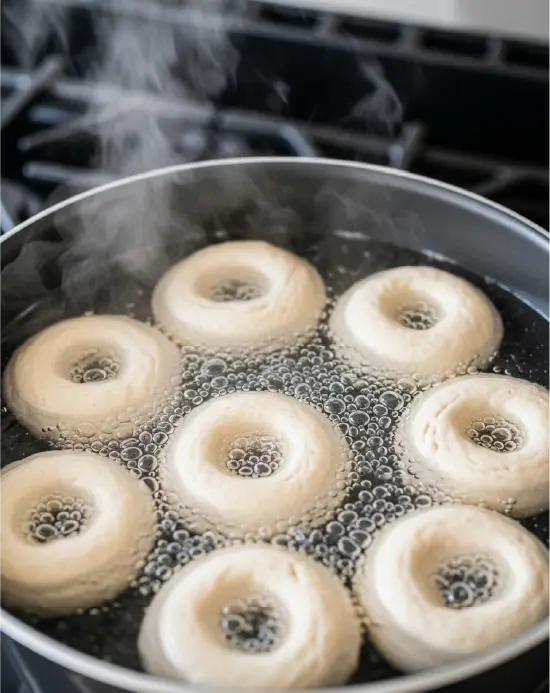
Notes & Variations
- Brush with egg wash before baking for a glossy finish.
- Add seeds or toppings (sesame, poppy, garlic) after boiling, before baking.
- Want a hint of whole grain flavor? Sub ¼ cup of the blend with oat flour.
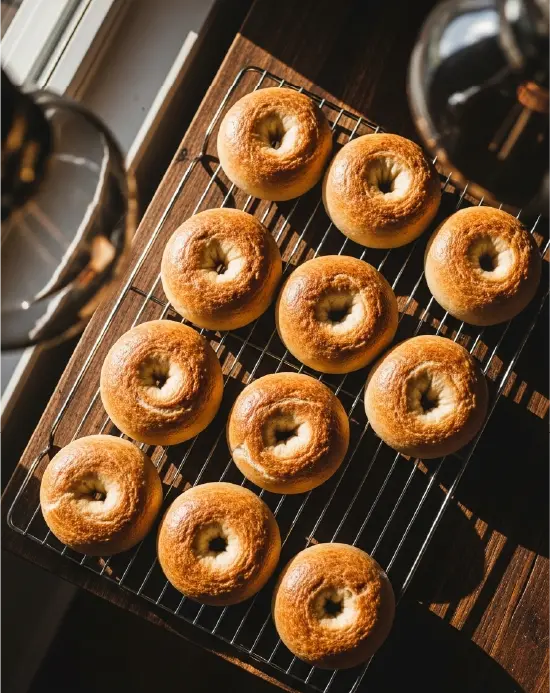
This easy base lets you test your own gluten free flour swap for bagels in real time—and tweak based on how your dough feels. The more you try, the better it gets.
What is a good gluten-free substitute for bread flour?
A strong gluten free flour swap for bagels includes sorghum or oat flour combined with tapioca or potato starch and xanthan gum. This blend mimics bread flour’s strength, chew, and bakeability without gluten.
Troubleshooting Your Gluten Free Flour Swap for Bagels
Let’s be honest—swapping flours isn’t always clean and pretty. The first time I tried a gluten free flour swap for bagels, my kitchen looked like a flour bomb went off, and the bagels? Flat. Sad. More like chewy cookies.
But like Grandma Dalida always said, “If something flops, it’s just the recipe telling you a secret.” So if your dough feels tricky or your results fall short, here’s how to adjust and try again.
Common Problems & Easy Fixes
- Too Dry or Crumbly
- Cause: Not enough hydration or missing binder
- Fix: Add more water 1 tbsp at a time, or double-check your xanthan/psyllium
- Dense or Gummy Texture
- Cause: Overmixing or too much starch
- Fix: Mix gently, reduce tapioca/potato ratio, and ensure a rest period before shaping
- Bagels Won’t Hold Shape
- Cause: Weak dough structure
- Fix: Add more binding agent, or use a firmer flour like sorghum or a pre-tested blend
- Pale, Dry Crust
- Cause: Oven too low or no egg wash
- Fix: Brush with egg or plant milk, bake at 375–400°F, or steam the oven briefly at the start
Remember, each gluten free flour swap for bagels has a learning curve. The dough feels different—less stretchy, more fragile—but that doesn’t mean it can’t bake into something golden, chewy, and deeply satisfying.
Why do gluten-free bagels turn out dense?
Dense gluten-free bagels usually need more hydration or a better binder. Adjusting your gluten free flour swap by balancing starches, adding xanthan gum or psyllium, and letting the dough rest can improve texture significantly.
Final Thoughts on Gluten Free Flour Swap for Bagels
If you’ve made it this far, then you’re already doing what most people never try—baking from scratch, with heart, and a little experimentation. And honestly? That matters more than perfection.
A gluten free flour swap for bagels isn’t about replicating store-bought to the crumb. It’s about reclaiming that comforting morning ritual—one bagel at a time—even if your pantry looks a little different now.
Whether you’re working around allergies, trying to feel better in your body, or simply curious about gluten-free baking, you deserve food that nourishes and delights. So don’t stress over flour ratios or imperfect shapes. Just keep showing up in the kitchen, the way Grandma Dalida did—with love, patience, and a wooden spoon.
Now, go preheat that oven. You’ve got this. 💛
Looking for More Recipes Like This?
If you loved this guide to the perfect gluten free flour swap for bagels, you’ll feel right at home with the rest of my kitchen tips and nourishing recipes. I share simple ideas rooted in heritage and made for busy lives—always with heart, and never with guilt.
👉 For more gluten-free recipes, breakfast ideas, and real-talk kitchen wisdom, follow me on Facebook:
Golden Era Recipes on Facebook
Let’s make mornings brighter—together. 💛


